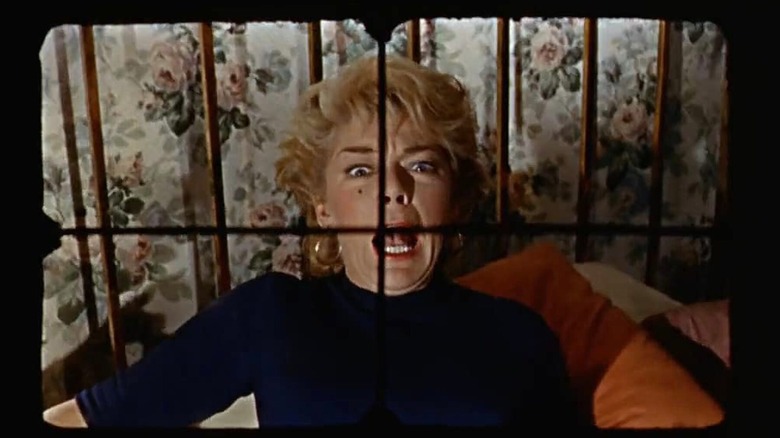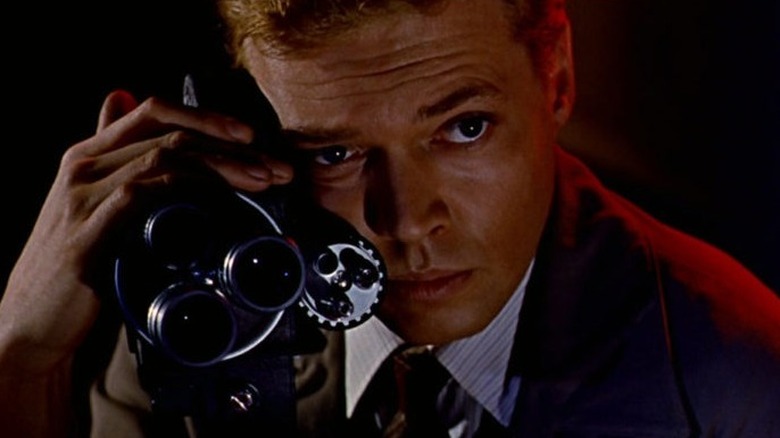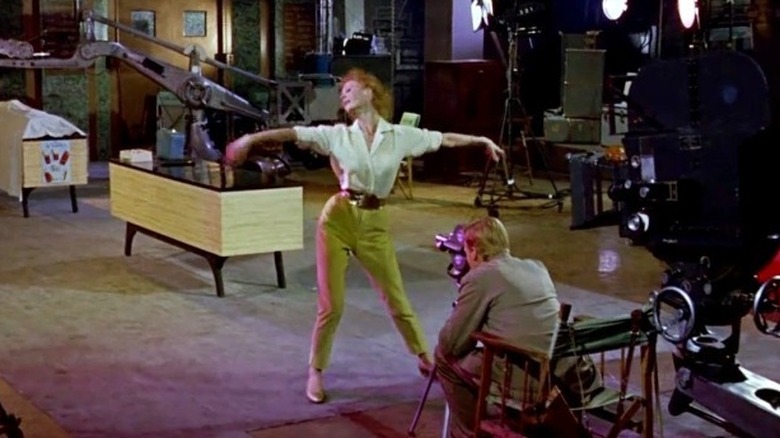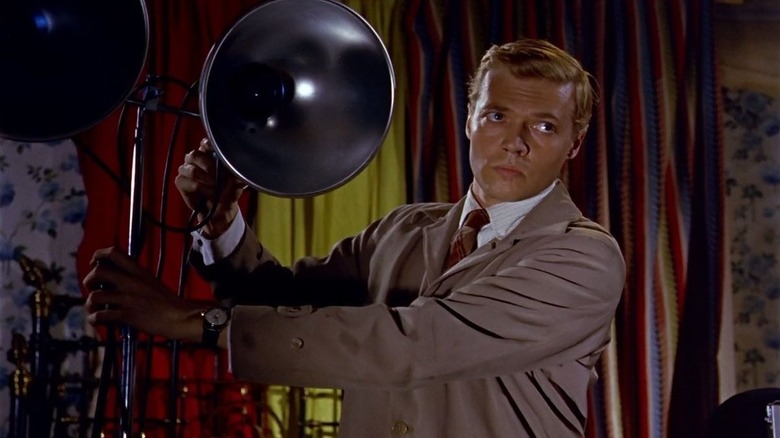One Of The Scariest Scenes In Peeping Tom Is A Window Into Terror
(Welcome to Scariest Scene Ever, a column dedicated to the most pulse-pounding moments in horror with your tour guides, horror experts Chris Evangelista and Matt Donato. In this edition, Matt turns the camera on its victims and lets the audience watch from a different perspective.)
Michael Powell's "Peeping Tom" is one of the earliest examples of found footage horror. It's not explicitly from a first-person perspective but employs the camera's lens as a weapon for a serial killer with a recording fetish. We're talking about a 1960s flick that well pre-dates "The Blair Witch Project," "The McPherson Tape," and even "The Legend of Boggy Creek." Powell's gazy classic is a trailblazer for serial-slashers like "Maniac" and "Man Bites Dog," where we're transported into the minds and optics of killers. "Peeping Tom" is invasively chilling as one of the earliest to market on complicit cinema.
For those who don't believe old-school horror titles can be scary because they lack contemporary effects, I point toward heavyweights like "Peeping Tom." Powell establishes societal horrors, predatory horrors, and gender-based horrors of the era. There aren't magnificent jump scares, but there are tremendously tense and traumatic scenarios where women are lured to their deaths by professional opportunities. Voyeurism, psychological experimentation, and everyone's desire to be a star become a concoction for terror that is witnessed at times up-close and too personally.
The setup
Mark Lewis (Carl Boehm) is an aspiring London filmmaker and the son of a renowned psychologist. He's currently only a tiny part of a film crew and not yet a famous director, so he works part-time photographing soft-porn pin-up pictures of women. Mark can be seen early and often spying on women in his apartment complex, sometimes with his camera rolling footage. Others presume he's practicing shooting techniques while holding his camera, but that's not always his intent.
We learn that Mark was a guinea pig for his father's experiments on fear and the nervous system. Mr. Lewis would record little Mark's reactions to stressful or uncomfortable situations, which takes a toll on the boy's psyche. As an adult, he's fixated on living out his fantasies from behind a camera's barrier — possibly because it blurs his sense of reality. The camera empowers Mark to become whoever he dreams of being, which turns dangerous once we witness the extent he's willing to go for a killer product.
The story so far
Usually, this would be the section where we detail the space between introductions and the scare sequence in focus — but "Peeping Tom" starts with its gravest disturbance. Powell doesn't hesitate to finger Mark as a madman. Those who've seen 2013's "Maniac" immediately recognize the homage ("Maniac" honors "Peepin Tom"), drawing parallels to Mark and Elijah Woods' Frank. Once the camera starts rolling — Mark's, that is — Powell assures his audience there's nothing but trouble ahead.
The scene
Mark wanders down a London street without much bustle, late at night or early in the morning. A sex worker (Dora, played by Brenda Bruce) is seen gazing into a storefront window, which grabs Mark's attention. He reaches into his trenchcoat, engages a 16mm camera hidden from sight, and starts rolling on the woman. Mark approaches as we see through the four-sectioned lens like a shark closing on its prey from afar.
As Mark gets intimately close, Dora turns around and announces it'll be "2 quid." Mark doesn't drop the camera and instead follows her as she leads, with high-heels clacking, to an apartment complex. Mark is told to shut the door after Dora walks inside, ascending the staircase, and we're still looking through Mark's camera. He frames her stocking-covered legs and backside from behind, sexualizing the woman as she climbs step-by-step toward her apartment.
We can't look away because we are Mark's eyes. So we feel awkward and a bit put off as we should.
Mark enters Dora's apartment as she readies herself for another client. There's a look of exhaustion on her face as the camera sticks to her figure as she undresses. Then Mark fixes something to the front of the camera that we cannot see, but Dora notices. A reflection now projects past Dora onto her wall while she looks a tad befuddled while sitting on the bed.
Mark shuffles closer to Dora as her eyes change from confused to terrified. More importantly, she's afraid not just of Mark — she's afraid of us. The closer the lens gets to Dora, the more she shrieks in terror. We can't see what's thrown her into a hysterical state; only the paralyzing terror is her squeals for help. Mark looms closer and closer until he's all but on top of her, then the camera cuts to a projector rolling that (presumably) Mark is watching. Cue the opening credits after Powell establishes his monster while leaving ultimate suspense that gnaws away at our psyche.
Why was Dora so petrified? What did Mark attach to the camera? What did he do to Dora? All these questions rattle through our heads within seconds because Powell understands the horror in what he doesn't snow — our imaginations are far more frightening.
The impact (Chris' take)
When talking about "Peeping Tom," it's important to remember that the film was not received well when it arrived in 1960. In fact, the film was so controversial, and so shocking to audiences of the era, that it effectively harmed director Michael Powell's career. The images of "Peeping Tom" seem downright chased when compared to the horror films that followed in its wake, but at the time, Powell's tale of terror was considered downright perverted.
Time, of course, has been kinder to the film, and decades of reappraisals have helped redeem "Peeping Tom" — it's considered by many to be one of the very first slasher movies (Alfred Hitchcock's "Psycho," another film that could be considered to be the start of the slasher genre, was released the same year, but arrived a few months after "Peeping Tom"). While "Peeping Tom" may have lost some of its edge over the years, the imagery remains striking — particularly this scene, which is so effectively chilling in its simplicity. "Less is more" is an adage many filmmakers forget. And yet, here is a prime example. We have no idea what is going on here, exactly. We just know that Brenda Bruce's streetwalker character grows increasingly terrified.
The POV camera lingers on her face, going closer and closer. In effect, we've been turned into the slasher here. It's as if we, the audience, are going in for the kill — or at least complicit. And the raw terror that radiates from Bruce as she screams, and screams, and screams is downright chilling. We eventually learn why she was screaming, but for now, we're caught up in the unyielding, unknowing terror of it all. Like both killer and victim, we can't escape, we can't look away. We can only watch.



